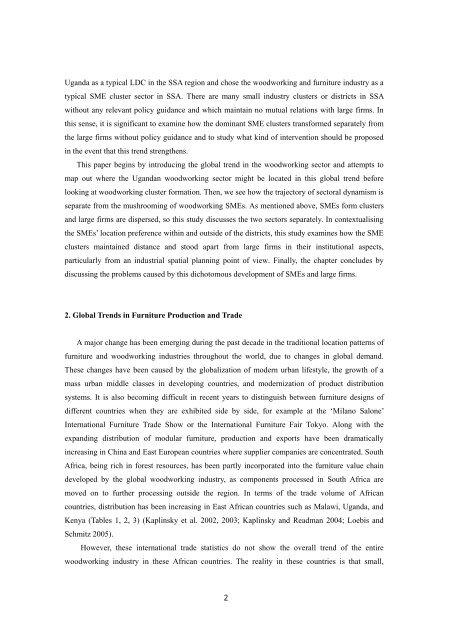Information - ARRIDE - IDE-JETRO
Information - ARRIDE - IDE-JETRO
Information - ARRIDE - IDE-JETRO
Create successful ePaper yourself
Turn your PDF publications into a flip-book with our unique Google optimized e-Paper software.
Uganda as a typical LDC in the SSA region and chose the woodworking and furniture industry as a<br />
typical SME cluster sector in SSA. There are many small industry clusters or districts in SSA<br />
without any relevant policy guidance and which maintain no mutual relations with large firms. In<br />
this sense, it is significant to examine how the dominant SME clusters transformed separately from<br />
the large firms without policy guidance and to study what kind of intervention should be proposed<br />
in the event that this trend strengthens.<br />
This paper begins by introducing the global trend in the woodworking sector and attempts to<br />
map out where the Ugandan woodworking sector might be located in this global trend before<br />
looking at woodworking cluster formation. Then, we see how the trajectory of sectoral dynamism is<br />
separate from the mushrooming of woodworking SMEs. As mentioned above, SMEs form clusters<br />
and large firms are dispersed, so this study discusses the two sectors separately. In contextualising<br />
the SMEs’ location preference within and outside of the districts, this study examines how the SME<br />
clusters maintained distance and stood apart from large firms in their institutional aspects,<br />
particularly from an industrial spatial planning point of view. Finally, the chapter concludes by<br />
discussing the problems caused by this dichotomous development of SMEs and large firms.<br />
2. Global Trends in Furniture Production and Trade<br />
A major change has been emerging during the past decade in the traditional location patterns of<br />
furniture and woodworking industries throughout the world, due to changes in global demand.<br />
These changes have been caused by the globalization of modern urban lifestyle, the growth of a<br />
mass urban middle classes in developing countries, and modernization of product distribution<br />
systems. It is also becoming difficult in recent years to distinguish between furniture designs of<br />
different countries when they are exhibited side by side, for example at the ‘Milano Salone’<br />
International Furniture Trade Show or the International Furniture Fair Tokyo. Along with the<br />
expanding distribution of modular furniture, production and exports have been dramatically<br />
increasing in China and East European countries where supplier companies are concentrated. South<br />
Africa, being rich in forest resources, has been partly incorporated into the furniture value chain<br />
developed by the global woodworking industry, as components processed in South Africa are<br />
moved on to further processing outside the region. In terms of the trade volume of African<br />
countries, distribution has been increasing in East African countries such as Malawi, Uganda, and<br />
Kenya (Tables 1, 2, 3) (Kaplinsky et al. 2002, 2003; Kaplinsky and Readman 2004; Loebis and<br />
Schmitz 2005).<br />
However, these international trade statistics do not show the overall trend of the entire<br />
woodworking industry in these African countries. The reality in these countries is that small,<br />
2




![Title [書評] 廣田義人著『東アジア工作機械工業の技術形成 ... - ARRIDE](https://img.yumpu.com/47139953/1/184x260/title-arride.jpg?quality=85)






